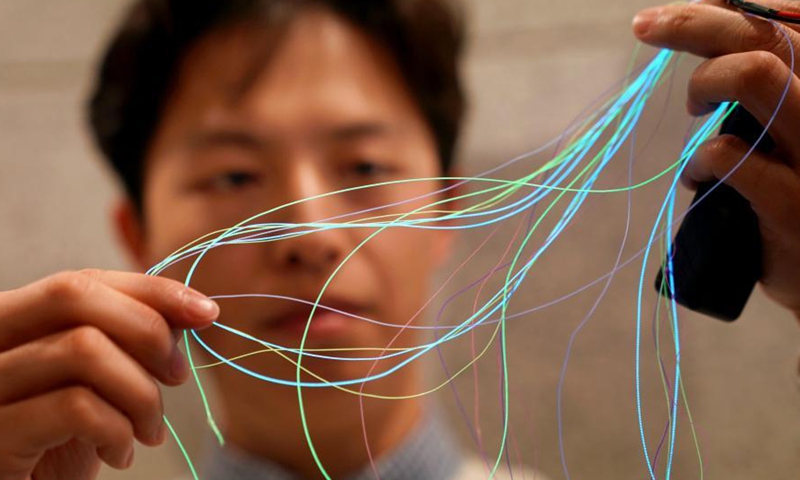
Chinese Scientists Invent Illuminating Fabric That Can Display Text
Want to read in a language you're more familiar with? Please click the pink icon below for one-click AIPlease click the pink icon top right for one-click AI translation
Scientists from Fudan University have developed a smart fabric with a display system that allows users to turn their clothing into a digital screen.
Scientists from Fudan University have developed a smart fabric with a display system that allows users to turn their clothing into a digital screen. Researchers hope that the invention will revolutionize the next generation of wearable technology.
The 6 meter-long, 25 centimeter-wide display textile created by the Shanghai-based university’s department of macromolecular engineering contains five sets of 105 electroluminescent units spaced 800 micrometers apart. The design effectively weaves a display screen into the fabric, according to a paper published in British scientific journal Nature on Wednesday. Electroluminescence, usually abbreviated to EL, is an electrical phenomenon in which a material emits light in response to the passage of an electric current.
SEE ALSO: Chinese Firm Develops Copper-infused Face Mask with Self-sanitizing Properties to Battle Covid-19
The project, led by Professor Peng Huisheng, required ten years of trial and error testing. In the end, the team managed to successfully develop transparent conductive weft fibers and luminescent warp fibers. When woven together, the two components form minuscule points of light similar to those on a digital display screen. Warp and weft are the two basic components used in weaving to turn thread or yarn into fabric.

The smart fabric can be washed, folded and stretched without affecting its brightness. Furthermore, clothes woven with this new material can closely follow the irregular contours of the human body, and are as light and breathable as ordinary fabrics, professor Peng told China Daily.
In a video released on the university’s website, a user is able to read and reply text messages from his sleeve. Another video shows a cyclist navigating a map from his arm.
Another image shows a researcher with a university badge woven into the fibers of his shirt. The badge illuminates when electricity passes through it.

“Integrating displays into textiles offers exciting opportunities for smart electronic textiles — the ultimate goal of wearable technology, poised to change the way in which we interact with electronic devices,” the team wrote in the paper.
The team envisions the technology to be used in various practical scenarios, and could be especially advantageous for users who cannot conveniently access a cell phone, such as bikers, motorcyclists, polar explorers, and geologists. Instead, they can tap on their clothing to access a display of real-time location information, or navigate their journey by wearing a map on their clothes.
Additionally, people with language barriers can use the dynamic sleeve display to communicate with others. It can also be implemented in the health care industry by collecting index data including brain waves.
In one experiment with the fabric, the team collected brainwaves from volunteers who had either been playing a race car game or meditating — simulating a person in a stressed or relaxed state.
When paired with a processor, the waves could then be translated into messages displayed on the fabric reading either “relaxed” or “anxious”.
“We have shown that an integrated textile system consisting of display, keyboard and power supply can serve as a communication tool, demonstrating the system’s potential across various aspects of the Internet of Things,” the team said.







